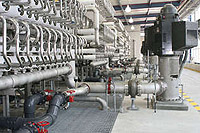Salt Water Goes Fresh in El Paso
January 10, 2008

<< Return to ‘Edge of the Desert’…
On Aug. 8, 2007, the largest inland desalination plant in the world opened in El Paso, Texas. Expected to provide 27.5 million gallons of freshwater to the growing population of El Paso, the Kay Bailey Hutchison Desalination Plant represents a burgeoning trend in the water community: desalinating salty, previously unusable, groundwater in response to a dwindling supply of freshwater. Although desalination will bring some relief to the water supply, it does pose a host of scientific challenges that geoscientists must examine more closely.
Generally, desalination takes place in coastal regions, where a plentiful supply of seawater is the source. In land-locked El Paso, however, the source is slightly salty, or “brackish,” groundwater from the Hueco Bolson aquifer. The aquifer is virtually tapped out of freshwater due to excessive groundwater pumping, but the brackish water remains, says J.P. Nicot, a research associate at the Jackson School’s Bureau of Economic Geology.
“When you picture an aquifer, especially in the Gulf Coast area, it’s kind of slanted on a plane,” Nicot says. “When you are close to the surface, recharge occurs with freshwater and then further down it starts getting brackish and gets more and more brackish until you reach the point of saline seawater.”
In the last 20 years of pumping of freshwater at the Hueco Bolson, brackish water had begun creeping up, causing several wells to shut down. Now, El Paso is trying to capitalize on that previously undesired brackish water in its desalination efforts. And other cities are following suit— San Antonio and Lubbock are also developing similar desalination schemes.

Nicot is pushing the cities and the state, however, to tread carefully. Because the freshwater and brackish water are collocated in the aquifer, efforts to pump brackish water need to avoid impacting the freshwater section of the aquifer where surface water over time will slowly replenish the source.
In general, scientists need to try to better understand what happens “in the long term when you start pumping brackish water,” Nicot says. “It’s not like freshwater, which is easily recharged through precipitation all the time.” As desalination plants pump for deeper and deeper brackish water, they will also have to deal with increasing salinity — which eventually can cause the price of desalination to skyrocket; the cost of desalination is proportionate to the level of salinity in the brackish water.
Another consideration, Nicot says, is disposal of the waste from desalination plants. “You take the brackish water out and you end up with freshwater on one side, but on the other side you also have what we call the concentrate, and you have to get rid of it,” he says. For coastal desalination facilities, that brine concentrate can go back into the ocean, but for a larger inland plant, such as the one in El Paso, the only option is deep well injection. The El Paso plant will be reinjecting the salty brine deep into the ground, several thousand feet. Geoscientists will need to study the long-term effects of such deep well injection, Nicot says.
Currently, Texas has 35 public water supply desalination plants, but the El Paso and San Antonio plants alone will double the desalination capacity of the state. Desalination will continue to be an attractive option in Texas, as it is becoming more cost-effective and giving policymakers more control over their resource, Nicot says, than, for example, a water transfer from another region. As desalination expands in Texas and worldwide, Nicot just hopes that science will have a strong voice in policy-making.
<< Return to ‘Edge of the Desert’…
By Lisa M. Pinsker
For more information about the Jackson School contact J.B. Bird at jbird@jsg.utexas.edu, 512-232-9623.
